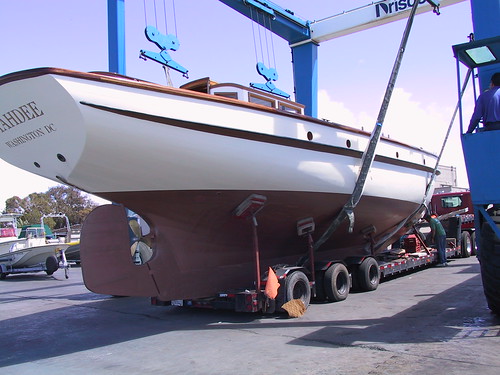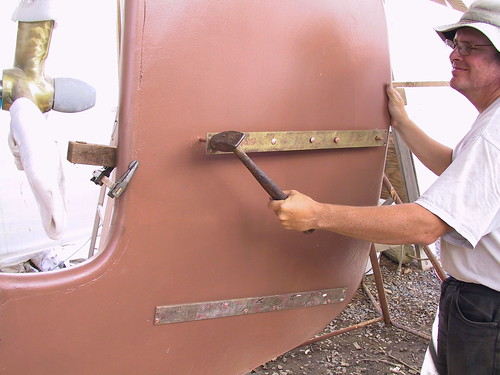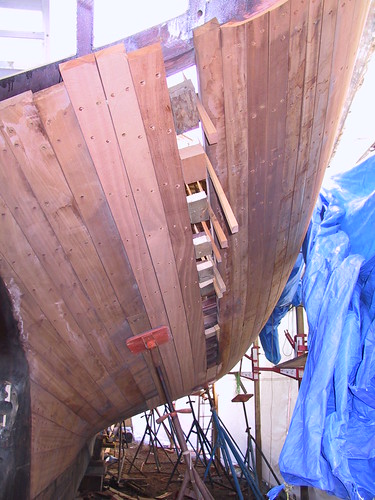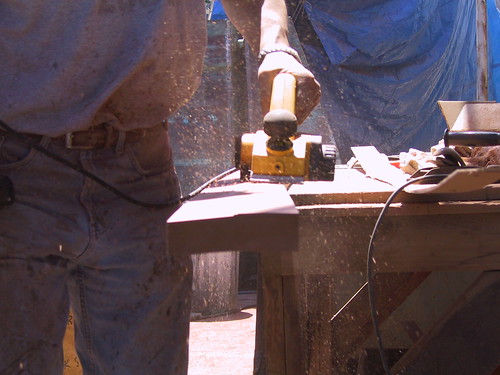Yep, ours is "copper painted" with Aquarius Marine's Coppercoat. Nice product, environmentally friendly, easy to apply yourself and cleans up with water. Negative is that the particular paint can't get wet for 72 hours after use. There are many bottom paints with high levels of copper. Ours is a non-ablative paint and I would not suggest that anyone use an ablative bottom paint with copper as there is much evidence of negative environmental consequences.
Paints are not waterproof coatings though some of the latex house paints do a great job of letting paint get under it (with a crack the substrate for example) but not dry out so they encourage rot on houses...but I digress. Water slowly permeates paint and does get to the hull. The process for a wood boat is that the paint provides the initial water proofing (for a few minutes to a few hours) then the (putty like) paying compound in the seams does the job for a bit (more minutes) then the cotton or oakum caulking material starts swelling with water further helping to keep water ingress at bay, and finally the wood itself swells sufficiently to be tight. If the planking job was done properly (on a carvel planked boat) the inboard edges of the planks almost (but not quite) crush each other tightly together while the outboard edges of the planking still have enough space to hold in the paying compound. The cotton or oakum is sandwiched behind that paying compound and in front of the almost-crushed inner edge of the plank. Some tightly seamed boats do not have caulking or paying, they are tight fit board-to-board. Some Scandinavian boats are built this way as are many of the early Concordia yawls. The outgage (angles of planking meeting each other) is different based upon wood species, moisture content of the planking stock, and other environmental conditions. Our boat was tightly seamed and had a 4 degree outgage for the outboard 2/3 of the planks and then tight for the inboard 1/3 of the plank. Our expectation was for crushing of the wood on that inboard (inside) seam.
It is very common when the boat is newly planked (as ours just was) for the first swelling to push a bit of the paying compound out (it is placed in with a concave curve but the swelling of the seams can make a little convex "pooch" outwards) and at a minimum there is an expectation that the paint with crack at the seams as it is also crushed outwards a bit. This happens above and below the waterline. In our case, the old oak keel is pooching alot where it had dried alot and we filled the dried out cracks with a bedding compound that could be pushed out of the wood when the oak soaked up water again; and we have one area of the planking (starboard side starting at the stem and working back about 20 feet) at and above the waterline which is seeing paint crushing outwards from the planking swelling up. I've already scraped and touched up the paint in that area twice (down to the waterline), will be tipping the boat (at a dock) on 12/14 for 3 days to scrape and paint topsides paint right at the waterline and I really look forward to our first haul out in 2010 to do a more thorough job.
When a boat is being repainted after having been in service for a while, any significant movement and crushing shouldn't happen. The paint will typically have sufficient elasticity to move with plank motion (which is very small in a yacht with good structural integrity and built with hardwood) rather than crack. If there are big cracks in the paint or difficulty in keeping paint on the hull, there may be underlying structural or movement issues.
Hope that answers your question.
Here are some pictures of the bottom with the copper paint and some pics planking the boat.
Here's a link where you can see the copper paint right before she went into the water
same pic but smaller here

You can see the pink color of the newly applied paint
here at this link. After the bronze bars were riveted thru the rudder, I went back and painted them, too.

same pic but smaller here
The last plank on the starboard side goes where the wedges are:
Link to big pic

Fitting a garboard plank (about 35 feet long)
link to big picture here

Planing a plank
Link here

Putting in the cotton caulking...
here you can see how small the seams actually are...about 3/32" on the outside of the plank.



















 Linear Mode
Linear Mode






























